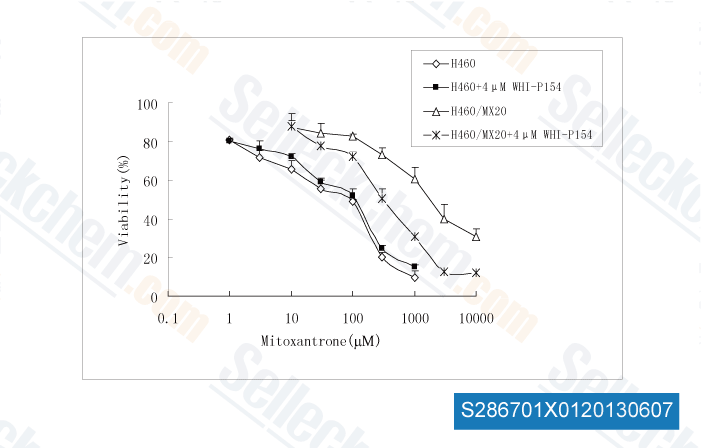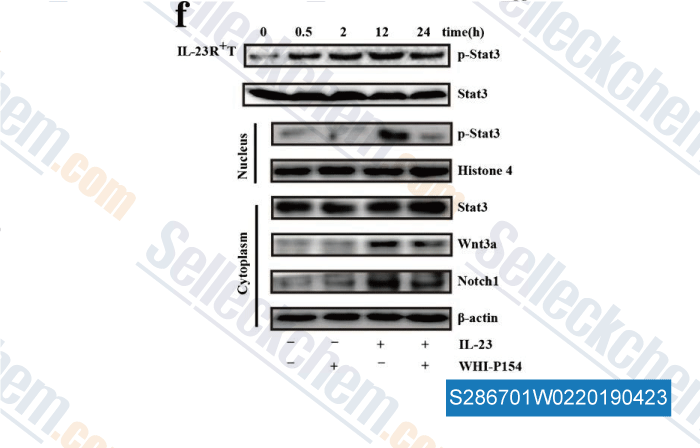|
How to Cite 1. For In-Text Citation (Materials & Methods): 2. For Key Resources Table: |
||
|
Toll Free: (877) 796-6397 -- USA and Canada only -- |
Fax: +1-832-582-8590 Orders: +1-832-582-8158 |
Tech Support: +1-832-582-8158 Ext:3 Please provide your Order Number in the email. We strive to reply to |
Technical Data
| Formula | C16H14BrN3O3 |
||||||||||
| Molecular Weight | 376.2 | CAS No. | 211555-04-3 | ||||||||
| Solubility (25°C)* | In vitro | DMSO | 75 mg/mL (199.36 mM) | ||||||||
| Water | Insoluble | ||||||||||
| Ethanol | Insoluble | ||||||||||
| In vivo (Add solvents to the product individually and in order) |
|
||||||||||
|
* <1 mg/ml means slightly soluble or insoluble. * Please note that Selleck tests the solubility of all compounds in-house, and the actual solubility may differ slightly from published values. This is normal and is due to slight batch-to-batch variations. * Room temperature shipping (Stability testing shows this product can be shipped without any cooling measures.) |
|||||||||||
Preparing Stock Solutions
Biological Activity
| Description | WHI-P154 is a potent JAK3 inhibitor with IC50 of 1.8 μM, no activity against JAK1 or JAK2, also inhibits EGFR, Src, Abl, VEGFR and MAPK, prevents Stat3, but not Stat5 phosphorylation. | ||||||||
|---|---|---|---|---|---|---|---|---|---|
| Targets |
|
||||||||
| In vitro | WHI-P154 is first described as a JAK3 inhibitor that displays no activity at JAK1 or JAK2. This compound inhibits STAT1 activation, iNOS expression and NO production in macrophages in vitro. But it is proved that this chemical also inhibits other common kinases including EGFR, Src, Abl, VEGFR, MAPK and PI3-K and induces apoptosis in human glioblastoma cell lines. [1] It inhibits glioblastoma cell adhesion and migration in the context of ECM.[2] This compound exhibits significant cytotoxicity against U373 and U87 human glioblastoma cell lines, causing apoptotic cell death at micromolar concentrations. The in vitro antiglioblastoma activity of this chemical is amplified > 200-fold and rendered selective by conjugation to recombinant human epidermal growth factor (EGF). In vitro treatment with EGF-P154 results killing of glioblastoma cells at nanomolar concentrations with an IC50 of 813 nM, whereas no cytotoxicity against EGF-R-negative leukemia cellsis observed, even at concentrations as high as 100 mM.[3] | ||||||||
| In vivo | The in vivo administration of EGF-P154 results in delayed tumor progression and improved tumor-free survival in a severe combined immunodeficient mouse glioblastoma xenograft model. Whereas none of the control mice remain alive tumor-free beyond 33 days (median tumor-free survival, 19 days) and all control mice have tumors that rapidly progress to reach an average size of > 500 mm3 by 58 days, 40% of mice treated for 10 consecutive days with 1 mg/kg/day this compound remain alive and free of detectable tumors for more than 58 days with a median tumor-free survival of 40 days. The tumors developing in the remaining 60% of the mice never reache a size > 50 mm3.[3] |
Protocol (from reference)
| Kinase Assay:[1] |
|
|---|---|
| Cell Assay:[3] |
|
| Animal Study:[3] |
|
References
|
Customer Product Validation

-
,

-
Data from [ , , J Mol Med, 2018, doi:10.1007/s00109-018-1724-8 ]

-
Data from [ , , Biol Open, 2018, 7(1) ]
Selleck's WHI-P154 Has Been Cited by 13 Publications
| Farnesoid X receptor activation by bile acids suppresses lipid peroxidation and ferroptosis [ Nat Commun, 2023, 14(1):6908] | PubMed: 37903763 |
| Farnesoid X receptor activation by bile acids suppresses lipid peroxidation and ferroptosis [ Nat Commun, 2023, 14(1):6908] | PubMed: 37903763 |
| Tyrosine Kinase Inhibitor Profiling Using Multiple Forskolin-Responsive Reporter Cells [ Int J Mol Sci, 2023, 10.3390/ijms241813863] | PubMed: 37762164 |
| Tyrosine Kinase Inhibitor Profiling Using Multiple Forskolin-Responsive Reporter Cells [ Int J Mol Sci, 2023, 24(18)13863] | PubMed: 37762164 |
| Establishment and characterization of immortalized sweat gland myoepithelial cells [ Sci Rep, 2022, 12(1):7] | PubMed: 34997030 |
| Interleukin 6 trans-signaling is a critical driver of lung allograft fibrosis [ Am J Transplant, 2021, 21(7):2360-2371] | PubMed: 33249747 |
| Revisiting Aldehyde Oxidase Mediated Metabolism in Drug-like Molecules: An Improved Computational Model [ J Med Chem, 2020, 31] | PubMed: 32191458 |
| A novel human colon signet-ring cell carcinoma organoid line: establishment, characterization and application [ Carcinogenesis, 2020, 41(7):993-1004] | PubMed: 31740922 |
| IL-21 promotes osteoblastic differentiation of human valvular interstitial cells through the JAK3/STAT3 pathway [ Int J Med Sci, 2020, 17(18):3065-3072] | PubMed: 33173427 |
| Interleukin-23 receptor signaling mediates cancer dormancy and radioresistance in human esophageal squamous carcinoma cells via the Wnt/Notch pathway [Zhou Y, et al. J Mol Med, 2018, 10.1007/s00109-018-1724-8] | PubMed: 30483821 |
RETURN POLICY
Selleck Chemical’s Unconditional Return Policy ensures a smooth online shopping experience for our customers. If you are in any way unsatisfied with your purchase, you may return any item(s) within 7 days of receiving it. In the event of product quality issues, either protocol related or product related problems, you may return any item(s) within 365 days from the original purchase date. Please follow the instructions below when returning products.
SHIPPING AND STORAGE
Selleck products are transported at room temperature. If you receive the product at room temperature, please rest assured, the Selleck Quality Inspection Department has conducted experiments to verify that the normal temperature placement of one month will not affect the biological activity of powder products. After collecting, please store the product according to the requirements described in the datasheet. Most Selleck products are stable under the recommended conditions.
NOT FOR HUMAN, VETERINARY DIAGNOSTIC OR THERAPEUTIC USE.
